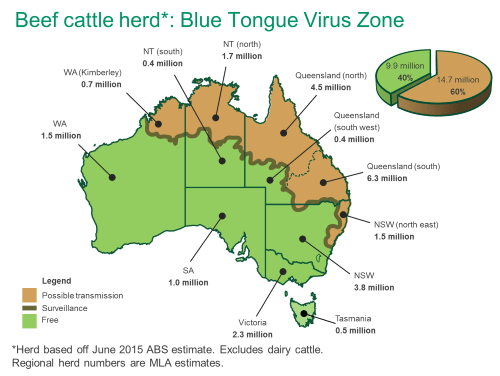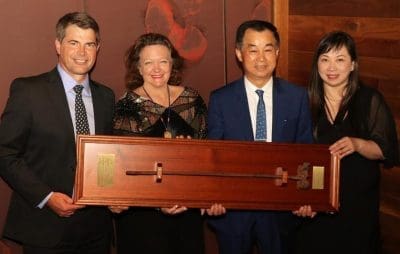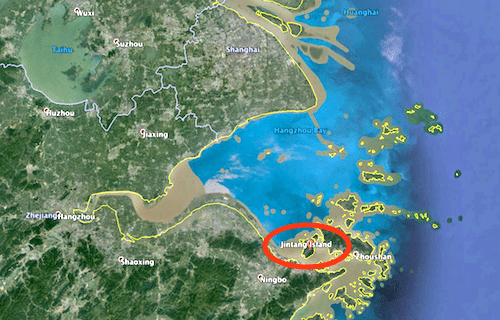Australian live cattle exporters continue to watch intently for indications as to whether mining magnate Gina Rinehart’s Hancock Prospecting will be able to secure a potentially game changing breakthrough deal to export cattle from northern Australia to China.
As first reported by Beef Central in June, Hancock Prospecting has reached agreement with a Chinese partner to export 150,000 cattle per year, growing to 300,000 per year, from Hancock’s northern cattle operations and purchased from other properties, to China each year.
The cattle would be shipped to a quarantine feedlot and processing facility on Jintang Island off Shanghai, with the processed, boxed beef then delivered into Chinese mainland markets.
A Hancock company spokesperson told Beef Central in early June the company was confident its planned use of a quarantine island would satisfy China’s concerns about Bluetongue and would allow the company to get a ‘special dispensation’ under the protocol to proceed with the trade.
(Similar plans to use quarantine islands have been floated by the Indonesian Government in recent years as it has pondered importing cattle from Brazil, but no such infrastructure developments have yet eventuated).
The strains of bluetongue that exist in northern Australian have never caused clinical disease in Australian cattle.
However, China continues to impose strict biosecurity constraints on cattle imports from the large part of northern Australia covered by the Bluetongue Virus possible transmission zone.
These conditions add significant costs and currently render the notion of shipping cattle from northern Australia to China commercially unviable.
Australian industry and Government negotiators have been working for more than a decade to convince China that it has nothing to fear from the strains of bluetongue found in northern Australia, and to reinforce that it is not the same virus strains that cause cattle health issues in Europe.
Indeed strains of Bluetongue are also present in China.
If approved, the Hancock deal would represent a major step forward for Australia’s fledgling cattle export trade to China.
Despite lots of hype about the trade’s potential, only three small air shipments and one sea shipment of Australian cattle have been exported to China since the new trade protocol was signed in 2015. Protocol conditions make it easier to ship cattle from southern Australia, but delays in having to build new physical supply chain facilities to satisfy the protocol conditions, and the high cost of Australian cattle, have largely inhibited growth of the trade to this point.

MLA analysis last year suggested that 60 percent of Australia’s cattle herd is located within Australia’s Blue Tongue possible transmission zone (shaded brown on the above map).
However, there is optimism in the trade that when Australian cattle prices start to ease and return to more affordable levels for importers, the Asian powerhouse could quickly become a significant market for Australian cattle exports.
Some exporters have commented privately to Beef Central that if Australian cattle prices were to ease by about 30c/kg liveweight it could trigger strong new demand from China – particularly from those customers who have spent money building expensive feedlots and processing plants; import-dedicated infrastructure they are now itching to fill with cattle.
In an ABC Landline interview aired last Sunday Hancock Prospecting chief executive Garry Korte said discussions with China were “well progressed” and the company was “very confident that that approval will be forthcoming in the next six months”.
“Jintang Island is isolated from the mainland and there’s strong support from the Chinese Government to develop an export protocol which would allow us to … live-export cattle into Jintang, which is effectively a quarantined area,” Mr Korte told the program.

Gina Rinehart and a staffmember present Shanghai CRED’s chairman, Mr Gui, with an original ‘SK’ Kidman branding iron, during the inaugural Kidman board meeting in Shanghai in May.
Few people would be game to underestimate what Australia’s richest woman and export titan Gina Rinehart can achieve.
But at the same time, trade insiders say it would be nothing short of “a miracle” if Hancock Prospecting can convince China’s trade quarantine authority AQSIQ to bend on protocol conditions it has shown no signs of bending on before in years of preceding trade negotiations.
Any livestock exporter looking to export livestock to China requires an import permit to be issued from the Chinese government (AQSIQ).
The import permit must be provided to the Department of Agriculture and Water Resources, and the department provides certification that the livestock being exported meet the conditions as per the agreed protocol.
DAWR advised Beef Central that animals sourced from the Australian bluetongue virus possible transmission zone can only be exported to parts of China at certain times of the year. China will specify these requirements when it issues import permits.
The protocol considers—when applying import conditions to the livestock sourced for export—the bluetongue virus status of the farms of origin and point of export in Australia and the season in China when bluetongue virus transmission does not occur.
More broadly, Australian livestock exporters also require a license (to export livestock) and, if they’re exporting feeder or slaughter livestock, an approved Exporter Supply Chain Assurance System (ESCAS).
DAWR said it does not discuss individual applications made by livestock exporters, as per the requirements of the Privacy Act 1988.
Asked if DAWR has had any involvement in the reported negotiations between Hancock Prospecting and China so far, a spokesperson said it had not. “Our understanding is that these are discussions on commercial arrangements”.
Australian Livestock Export Council chief executive officer Simon Westaway said exporters welcomed and maintained strong support around the significant progress being made in the development of Hancock’s live cattle supply chains and export partnerships.
“As we’ve previously stated, Hancock’s recent announcements, and forward progress is a real vote of confidence in the future direction of Australia’s livestock export industry,” Mr Westaway told Beef Central.
“As the world’s largest meat market, China is clearly a priority market for Australian livestock cattle exports.
“As it develops over time, we believe China will complement a long-standing, successful trade in livestock dairy exports and as such, this requires the focus around the inhibitors on market access.
“The scope and scale of the Chinese market, along Australia’s long-standing trade and diplomatic relations across many industry sectors, provides the platform for significant opportunities for our sector and for wider Australian red meat exports.
“Those Australian producers and exporters who can respond to China’s demand for live cattle by delivering high-quality, healthy animals through reliable supply channels and with the world’s best animal welfare practices, we believe can reap significant benefits for their efforts.



The one vaguely viable (though still full of holes) argument the live export industry and its supporters have ever had, was that some countries “need” (read “want”) live animals for cultural or lack of refrigeration reasons (even though household refrigeration ownership in the oil-rich Gul countries we export to is at 99% and even in Indonesia, at over 75%.
Now we are sending live cattle to Cambodia, knowing that they are processing them there and on-selling to Vietnam, Thailand and China, and the richest woman in Australia is selling Australian cattle into the country with arguably the worst animal cruelty record on the planet… for what? To create Aussie jobs? NO – to reduce Aussie jobs.
China is our fifth-biggest buyer of beef (and growing), from cattle raised and slaughtered in Australian, to Australian standards, under Australian law, by Australian workers and Gina is intentionally and blatantly undermining that by making it easier and cheaper for them to import live cattle and process them themselves.
Australian beef and sheep meat is in high demand around the world and we can and must insist that any that is exported to other countries, MUST be on the hook and not on the hoof.
I would like to talk to anyone who can provide contacts or has an interest in developing a feedlot backgrounding protocol for livex to China out of NW Qld.
w.krieg@bigpond.com